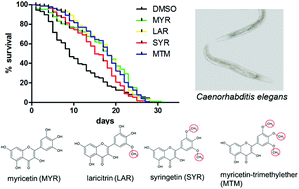Methylated derivatives of myricetin enhance life span in Caenorhabditis elegans dependent on the transcription factor DAF-16†
Abstract
Only certain flavonoids have been shown to enhance life span. This was pointed out for e.g. myricetin in the nematode Caenorhabditis elegans. However, the structural requirements responsible for this effect are not known. We used methylated derivatives of myricetin (laricitrin, syringetin, myricetintrimethylether) to investigate if free OH moieties in the B-ring are necessary for the life span extending effect. In analogy to myricetin, all derivatives increased the life span, decreased oxidative stress (DCF) and decreased the accumulation of lipofuscin. In contrast to myricetin, the methylated compounds strongly enhanced the resistance against thermal stress. Furthermore, treatment with the derivatives induced a much stronger nuclear localization of the DAF-16 transcription factor (FoxO homologue). Additionally, no antioxidant effects and only minor effects on life span prolongation and stress resistance were detectable for the methylated compounds in a DAF-16 deficient nematode strain. Comparable to the dietary flavonoid myricetin, the methylated myricetin derivatives laricitrin, syringetin and myricetintrimethylether strongly enhance the life span of C. elegans. Therefore, OH groups of ring B are not necessary for this effect. Only the methylated compounds increase the stress resistance of the nematode which was dependent on DAF-16. These findings suggest that methylation of myricetin increases the biofunctionality.


 Please wait while we load your content...
Please wait while we load your content...